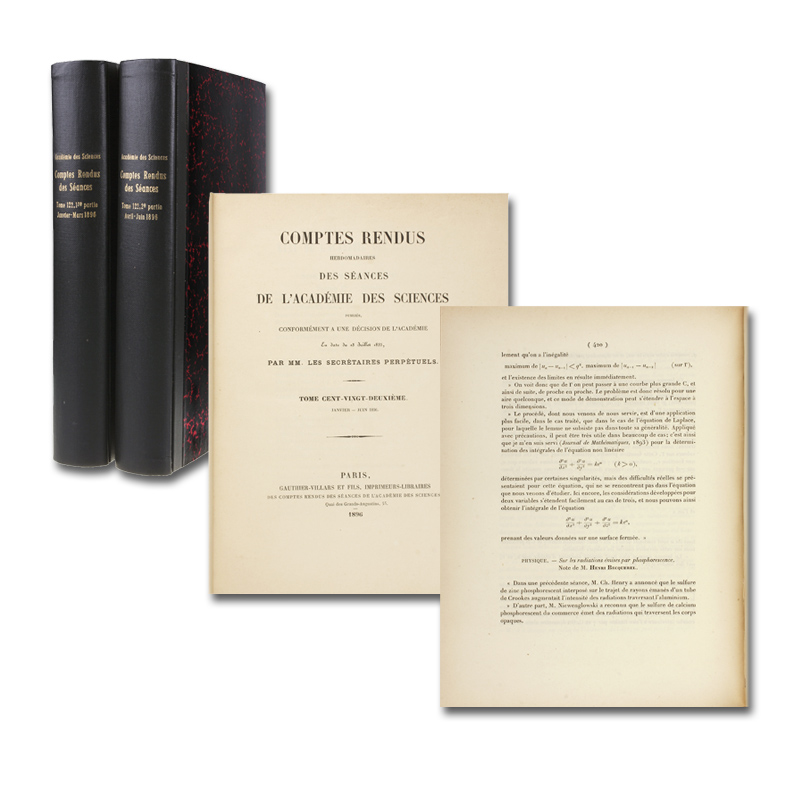75309-02
Sur les radiations émises par phosphorescence. 2 S. - Und: Derselbe. Sur les radiations invisibles émises par les corps phosphorescents. 3 S. - Und: Derselbe. Sur quelques propriétés nouvelles des radiations invisibles émises par divers corps phosphorescents. 6 S. - Und: Derselbe. Sur les radiations invisibles émises par les sels d'uranium. 6 S. - Und: Derselbe. Sur les propriétés différentes des radiations invisibles emises par les sels d'uranium, et du rayonnement de la paroi anticathodique d'un tube de Crookes. 6 S. - Und: Derselbe. Observations relatives ŕ la réponse. 2 S. In: Comptes rendus. Tome 122 in 2 Bände.
Paris, Gauthier-Villars, 1896. - (27,5 x 21 cm). 804 S./ SS. (805)-1633. Moderne Halbleinwandbände im Stil der Zeit.
Erste Ausgabe der sechs Arbeiten Becquerels zur Entdeckung der Radioaktivität. - "In February 1896 Charles Henry reported to the Académie his discovery that phosphorescence could be induced in certian substances by exposure to sunlight. In the same month Becquerel reported that uranium was among those substances. Like all his other early papers on the subject, this appeares in the 'Comptes rendus' and was entitled 'Sur les Radiations Invisibles...'. In a second paper 'Sur quelques Propriétés Nouvelles...' he reported the astonishing fact that uranium was capable of fogging photographic plates even without previous exposure to sunlight and when the plates themselves were completely protected from ordinary light. In a third paper, March 1896, 'Sur les Radiations invisibles...' Becquerel discarded phosphorescence completely and declared that the emanations from uranium constituted an entirely new and unsuspected property of matter, which in his seventh paper he named 'radioactivité'. He also found that the uranium rays discharged a gold-leaf electroscope, which is still used as one method of detecting radio-activity" (PMM). - Das erste Blatt etwas gebräunt, sonst sauber und gut erhalten. - DSB I, 558; PMM 393; Garrison-Morton 2001 (I)
Sur les radiations émises par phosphorescence. 2 S. - Und: Derselbe. Sur les radiations invisibles émises par les corps phosphorescents. 3 S. - Und: Derselbe. Sur quelques propriétés nouvelles des radiations invisibles émises par divers corps phosphorescents. 6 S. - Und: Derselbe. Sur les radiations invisibles émises par les sels d'uranium. 6 S. - Und: Derselbe. Sur les propriétés différentes des radiations invisibles emises par les sels d'uranium, et du rayonnement de la paroi anticathodique d'un tube de Crookes. 6 S. - Und: Derselbe. Observations relatives ŕ la réponse. 2 S. In: Comptes rendus. Tome 122 in 2 Bände.
Paris, Gauthier-Villars, 1896. - (27,5 x 21 cm). 804 S./ SS. (805)-1633. Moderne Halbleinwandbände im Stil der Zeit.
Erste Ausgabe der sechs Arbeiten Becquerels zur Entdeckung der Radioaktivität. - "In February 1896 Charles Henry reported to the Académie his discovery that phosphorescence could be induced in certian substances by exposure to sunlight. In the same month Becquerel reported that uranium was among those substances. Like all his other early papers on the subject, this appeares in the 'Comptes rendus' and was entitled 'Sur les Radiations Invisibles...'. In a second paper 'Sur quelques Propriétés Nouvelles...' he reported the astonishing fact that uranium was capable of fogging photographic plates even without previous exposure to sunlight and when the plates themselves were completely protected from ordinary light. In a third paper, March 1896, 'Sur les Radiations invisibles...' Becquerel discarded phosphorescence completely and declared that the emanations from uranium constituted an entirely new and unsuspected property of matter, which in his seventh paper he named 'radioactivité'. He also found that the uranium rays discharged a gold-leaf electroscope, which is still used as one method of detecting radio-activity" (PMM). - Das erste Blatt etwas gebräunt, sonst sauber und gut erhalten. - DSB I, 558; PMM 393; Garrison-Morton 2001 (I)
950 €

